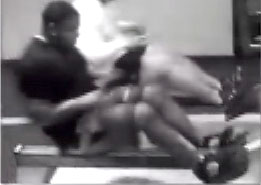Pablo Sandoval, Injury Analysis
After a tremendous effort to lose weight during the last off-season to save his job, Mr. Pablo Sandoval is suffering today from a hand fracture. Everybody is surprised and the media cries the bad luck of Mr. Sandoval.
It is well known that Mr. Sandoval has a history of body weight fluctuations that he is struggling to control. As a consequence he received a strong warning from the club management at the end of 2010 asking him to lose weight. This is why an athlete, like him, that sees his job under risk, is capable of jeopardize his own biology and end in a worse situation.
To comply with the club request Mr. Sandoval started in November 2010 a rigorous training and dieting process that he described in a 2:47 minutes video clip in his web page. The goal was to lose 35 pounds of body weight before the beginning of the 2011 season. In order to do so, he engaged in a low carb and high protein diet accompanied with a high intensity physical training program. By February 2011, his weight dropped from 274 to 241 pounds and he became the media king of "effort, discipline and performance". What he and the media did not know was that the same process that seemed to help him to escalate the ladder of success was the same that, unnoticed, was most likely creating the bases for today's fracture.
The nutritional literature suggests that any diet design that intent to accomplish a body weight loss should secure the fundamental sources of nutrients in a correct quantity and proportionality according to the subject's requirements. Also the design should NOT allow loosing more than 3 to 4 pounds of body weight a month (hopefully mainly from fat mass), to give enough time for the different physiological systems to adjust to the new situation and establish a new level of body steady state.
The result of what Mr. Sandoval was instructed to do is presented in the following graph that I prepared:
As the graph shows, the speed of Mr. Sandoval weight decrement is several times faster than what it is recommended for a healthy outcome.
How did it happen and what are the consequences?
a) Restriction of the carbohydrates intake: the body's carbohydrates reserves are depleted in few days and as a consequence the degradation of muscle proteins increases.
b) Decrement of total intake calories: the body looks for compensation in the internal resources and finds it in the proteins degradation that uses as sources of energy.
c) High intensity training process that increases the carbohydrates demand. Since carbohydrates are not supplied the protein degradation becomes the available resource to obtain energy.
As we can see the three main strategies utilized to "help" Mr. Sandoval to lose weight produced mainly carbohydrates depletion, muscle degradation (decrement of muscle mass) and its consequent muscle-skeletal weakening.
While the already explained protein catabolic process was happening, bones where most likely also being affected.
The high intensity activities that Mr. Sandoval had to perform (see pictures) require always-high amounts of calcium for muscle contraction. The needed calcium is usually supplied by local reserves in the muscle cells themselves. But, when the supply is not enough (because lack of intake or excessive demand), the closest bones (bones are our main reserve of calcium!) provide the rest of necessary calcium. The calcium that the bone releases decreases the local bone density and therefore its strength (osteoporosis).
If the previous explained situations of protein and calcium uncontrolled intake/demand are prolonged enough, the system weakens and the risk of damage increases.
In Mr. Sandoval's case, his hands are one of the most loaded areas of his body with several hundreds of repetitions of bating, throwing, catching and weight lifting per week, therefore an area with high risk of injury.
Do you still think that it was an unfortunate and unexpected bad luck, or a created environment waiting for an injury to happen?














Daniel, I don't know much about the body's functioning, but your explanation tends to make sense. Since the off season time to drop the weight was so short, what would you have suggested he do?
ReplyDeleteI am sure he knows, as most of us know, that to let the body slip into the overweight state forces bad decisions.
Could a training program, where-in the impact of various body parts was reduced, help and couldn't weight be lost by cycling, rowing and many other non-impact types of training?
I think that you raise a good point about the weight loss over time comment; however, I think 1-2#/week is just fine which doubles your figure and makes his weight loss fairly structured. I think it probably had a slight affect on his vulnerability, but you are making a mountain out of a mole hill.
ReplyDelete@Vic, I am sure rowing was incorporated into his training, but impact is a part of his life and occupation and therefore shouldn't be avoided but logically attacked.
Final thought - I think he did an amazing job changing his body. Perhaps too good? Maybe, but this is much more a function of luck/lack of than bone density.